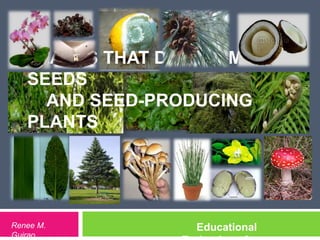
Plants
- 1. PLANTS THAT DO NOT MAKE SEEDS AND SEED-PRODUCING PLANTS Renee M. Educational Guirao
- 3. PLANTS THAT DO NOT MAKE SEEDS
- 4. Plants that Do Not Make Seeds There are different kinds of plants in this group. What is common to them is that they do not produce seeds. Some of them have leaves, roots and stems and some have parts that look different.
- 5. Plants that Do Not Make Seeds Are divided into three important groups; namely: • thallopytes (algae and fungi) • Bryophytes (mosses, liverworts) • Pteridophytes (ferns, club mosses, horsetails)
- 6. Thallophytes Simplest group of plants They lack true roots, stems, leaves and flowers. Example are algae and fungi.
- 7. Fungi Molds, mushroom and yeasts are examples of fungi. Magic Mushrooms Fungi in fruit
- 8. Fungi Molds are commonly seen growing on fruits and breads. They cause food spoilage. Some molds cause diseases but other molds are helpful. They are the source of penicillin and antibiotic drugs Penicillium fungi in grapes. Penicillin and antibiotic drugs
- 9. Fungi Yeasts are used in making wines, cheese and make the dough rise so helps make a light tasty bread.
- 10. Life Cycle of Thallopythes
- 12. Examples of Thallophytes: Algae • Algae have green coloring called chlorophyll. • They are the most important food makers in the water environment. • They supply the food and oxygen for fishes and other water organisms. • Some algae, called seaweeds supply agar, a jelly on which bacteria are grown in science laboratory. seaweeds
- 13. Life Cycle of Algae
- 14. Bryophytes They do not have roots and stems, they have simple leaves. They can make their own foods . They live in moist places as well as on rocks and stone walls. Examples of bryophytes are liverworts and mosses
- 15. Examples of Bryophytes: Liverworts Mosses
- 18. Pteridophytes: They have true roots, stems and leaves, but they do not have flowers, fruits and seeds. Some grow as the size of your fingers, some can grow into trees. They can make their own foods. They grow in moist, shady places. They are easy to identify because of their delicate leaves called fronds.
- 19. Examples of Pteridophytes: Ferns, club mosses and horsetails. Ferns Horsetail s
- 20. Life Cycle of Pteridophytes
- 21. Sori
- 23. Seed-Producing Plants: They are the most familiar plants. They all have true roots, stems and leaves. Trees, grasses, cacti and flowering plants are all seed producing plant. Seed-producing plants are also called spermatophytes.
- 24. Seed-Producing Plants: Are further grouped into two: • Gymnosperms or flowerless seed plants • Angiosperm or flowering plants
- 25. Gymnosperms: Gymnosperms are plants with exposed seeds. That is seeds are not inside a fruit. Examples of gymnosperms are pine trees, cypress and cedar. They are seed producing plants which do not have true flowers. Most gymnosperms grow cones. Conifers are the most familiar gymnosperms. Pines, firs, spruces and redwoods are all conifers. Conifer means cone bearing.
- 28. Seed-Producing Plants: Are further grouped into two: • Gymnosperms or flowerless seed plants • Angiosperm or flowering plants
- 29. Angiosperms Angiosperms are plants whose seed are produced within fruits. Most plants that you know are seed plants that produce flowers. They come in different forms: trees, shrubs, vines and herbs. Angiosperms are divided into two groups: • Monocots • Dicots
- 30. Monocots Monocots are seed plants that have only one seed leaf or cotyledon. “Mono” means one. The leaves of monocots are narrow with a parallel vein pattern. Monocots have fibrous roots. A fibrous root is made up of roots growing in clusters. A taproot has a single big root with smaller growing from it. Examples of monocots are corn, onions, lilies, orchids, tulips, palms and grasses. Palms are monocots that grow as tall as trees.
- 31. Monocots
- 32. Monocots
- 33. Seed of Monocot Seed of Dicot
- 34. Dicots Dicots are plants having two seed leaves. “Di” means two. A dicot seed has two cotyledons. The flowers of dicots are found in multiples of four or five. The bundles of the vascular tissue inside a dicot stem are arranged in a ring. Leaves of dicots have branching pattern of veins. Common dicots include avocado, mongo, tomatoes, peas, squash, lettuce and broccolli.
- 35. Dicots
- 37. Double Fertilization in Angiosperms
